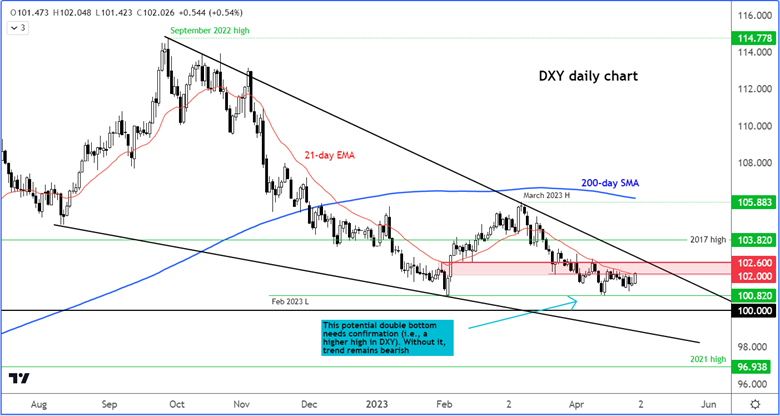Ahead of more US inflation data and key central bank decisions from the Fed and ECB next week, the US was higher on Friday, supported by a +200-pip rally in the USD/JPY pair, which had extended its post-BoJ recovery to above 136.00 at the time of writing, states Fawad Razaqzada of Trading Candles.
All yen pairs have sold off after the Bank of Japan’s inaction on yield curve control has supported expectations that ultra-loose monetary policy will remain in place for longer. We have seen the likes of the EUR/JPY and GBP/JPY surging higher.
Coming Up: Core PCE Price Index
The focus will remain on the dollar ahead of the publication of Core PCE Price Index, which is the Fed’s favourite measure of inflation. If this shows weakness, then watch out for a rally on the likes of the EUR/USD and GBP/USD. However, if it comes in stronger, then the USD/JPY will be the one to watch for further upside momentum.
ECB Could Hike Rates Two More Times
As we move to the middle parts of Q2, one of the most aggressive central bank tightening cycles ever is reaching its final stages. I think that currencies, where the central bank is relatively more hawkish, should perform better than those where rate hiking is already paused or where the central bank is turning dovish.
Given that the ECB is likely to hike at least two more times this year, I reckon the EUR/USD could climb toward the mid-1.10s in the coming months. But in the short term, I wouldn’t rule out a pullback from around the 1.10 area as traders digest incoming economic data and more central bank rate decisions next week.
At 3.5%, the ECB’s benchmark interest rate is at its highest level since 2008. After two consecutive 75bp hikes, the ECB dropped to 50bp over the past three meetings and it’s possible we could see them drop to 25bp on Thursday.
Can Dollar Index Break Resistance?
While the yen selling off has supported the dollar recovery, it remains to be seen whether the Dollar Index will be able to rise significantly from here.
The US dollar may struggle against currencies where the central bank remains more hawkish than the Fed. I think that the ECB has more policy tightening work left, which should keep the US dollar undermined and the euro underpinned. However, it is worth noting that a lot of this is already priced in.

Source: TradingView.com
Tactically, I will maintain an overall bearish view on the dollar until something fundamentally changes to trigger a breakout above the trend resistance of the falling wedge pattern around the 103.00 area. Even then, a higher above 105.88 would still be required to confirm a bullish reversal on the Dollar Index.
So, for the time being, there’s no clear bullish bias on the dollar, which, by default, makes me bearish. But if the charts tell me otherwise, I would be quick to drop by view.
US Dollar: Policy Tightening Impact To Be Felt on Economy
For the dollar to regain renewed buying strength against its rivals in the coming quarter, we may need to see another acceleration in the rate of inflation. But headline CPI has been falling for ten consecutive months, most recently dropping to a 5.0% annual pace in March. Let’s see how strong or otherwise the Fed’s favourite inflation measure—core PCE—will be later today.
The markets continue to price in another 25bp Fed hike to 5.25% next week. The market pricing implies this will be the terminal rate. Yet, comments from Fed officials remained hawkish into the blackout period. So, look for clues to decipher whether it is a hawkish hike (+25bp with more to follow), or a dovish one.
The positive influences of a contractionary Fed policy have been mostly priced in. The negatives haven’t. High rates will be here for a while. They could hurt housing market activity as disposable incomes are squeezed even more. We could see more tech sector job cuts, leading to a rise in the unemployment rate… and eventually a sharper-than-expected slowdown in economic activity, and thus sooner-than-expected rate cuts – possibly as early as the end of this year.
Another negative influence on the dollar is the debt ceiling debacle. Funding has been secured until the end of Q2. Thereafter, the US government might default on its obligations. The ceiling is likely to be eventually raised again like every year, but that’s not to say it won’t impact investor sentiment towards US assets while the Democrats and Republicans try to call each other’s bluffs.
Forex Outlook: Where are EUR/USD, GBP/USD, and EUR/JPY headed?
If the evidence continues to point to weaker inflation and growth in the US, then it would be difficult to be too positive on the dollar outlook. I, therefore, expect the currencies of countries where inflation is relatively high, economic activity is mostly positive, and the financial stability risks are low, to outperform. The likes of the eurozone and the UK come to mind.
Consequently, I envisage a sustained breakout above 1.1000 on EUR/USD and think the GBP/USD will move north of 1.2500, providing risk appetite does not deteriorate so significantly that it supports the dollar on haven flows. The USD/JPY is clearly on the rise today, but even if it reverses, the downside risks could be limited as the Bank of Japan is likely to maintain its ongoing policy settings under its new governor for a while yet. The EUR/JPY could climb to 150.00, and thus reach its best levels since 2014.
What Could Support the Dollar?
Lots of factors could go in its favour, including a rebound in inflation or sticky inflation, or a sudden recovery in economic data. But one of the key factors to support the dollar is if we see a sustained period of risk-off environment across the financial markets. The USD could benefit from haven flows in that case.
To learn more about Fawad Razaqzada visit TradingCandles.com.




















